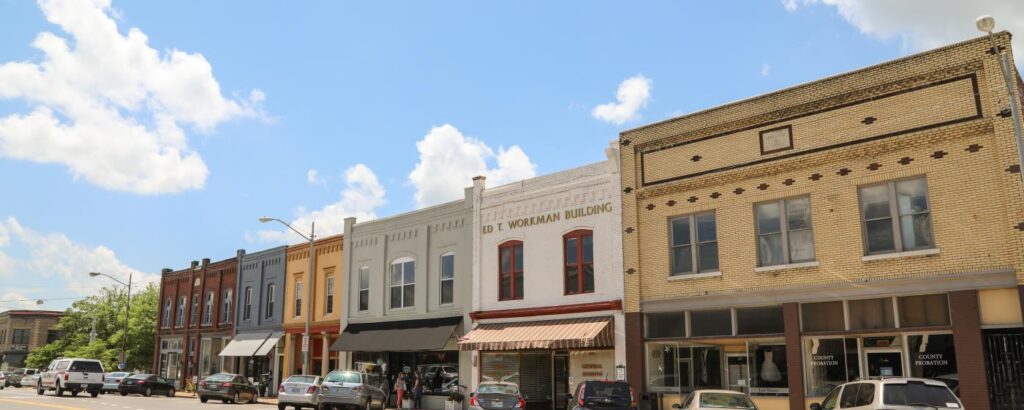HOA Management in Irmo, SC
Just decades ago, Irmo was a sleepy town located on the eastern shores of Lake Murray. Today, Irmo is a bustling suburban lake town just minutes from downtown Columbia.
Irmo, or the Town of Irmo, South Carolina, is located in both Lexington County and Richland County. While some may believe the town name, “Irmo,” is of Native American origin; This name is actually derived from the first two letters of the last names of two people who were instrumental in the town’s development. These two people being Captain Cadwallader .J. Iredell, and Henry C. Moseley. The original settlement of Irmo sprang up around a “water stop” for the Columbia, Newberry, and Laurens Railroad. Iredell was secretary, treasurer, and director of the railroad, and Moseley was president and director.
Irmo has two town monikers or mottos: “Gateway to Lake Murray” and “Home of the Okra Strut.”
Irmo Location – Latitude: 34°05′10″N, Longitude: 81°10′59″W.
Irmo’s standard delivery zip codes are 29063, 29210, and 29212.
Telephone area codes for Irmo are 803 and 839.
Irmo’s 2019 estimated population was 12,483, per the U.S. Census Bureau. Irmo’s total area is 6.26 square miles, per the 2010 U.S. Census Bureau. Irmo is inside the Columbia Metropolitan Statistical Area (MSA), which consists of the counties of Calhoun, Fairfield, Kershaw, Lexington, Richland, and Saluda. Irmo’s population of 12,483 makes it the fifth-largest municipality in the Columbia Metropolitan Statistical Area. As of 2020, the estimated population of the Columbia Metropolitan Statistical Area was 847,397. The Columbia MSA is the second largest MSA in the state after the Greenville MSA. In the United States, the Columbia Metropolitan Statistical Area, as measured by population, is the 69th largest.
A Brief Historical Overview of Irmo & the Surrounding Area
The first written record of the future Lexington and Richland counties originates from the expedition of Spanish explorer Hernando de Soto’s expedition that arrived in the area in 1540. The tale of the expedition is first published in 1557 with the work of a Gentleman of Elvas. The author was purportedly an anonymous Portuguese knight who was a member of the expedition. The Spanish king’s factor (accountant), Luys Hernández de Biedma, produced a detailed report of the expedition that was filed in Spanish King Charles I’s court in 1544. De Soto’s secretary, Rodrigo Ranjel, kept a journal of the expedition and this was utilized by Gonzalo Fernández de Oviedo y Valdés in writing La historia general y natural de las Indias. The aspects of the work based on Ranjel’s journal were only published in 1851. Unfortunately, Ranjel’s expedition journal has been lost to history.
De Soto’s expedition began in 1539, when his nine ships disembarked just south of present-day Tampa, Florida. His expedition was in search of a land route to China and treasure. The expedition included around 600 men and 220 horses. This became the most penetrating expedition of the interior of what would become the United States nearly 250 years later. Over the centuries, this expedition also became known for the brutality shown towards many of the Native Americans encountered and for first exposing them to European diseases that eventually devastated their population.
The expedition traveled through present-day Florida and into present-day Georgia. In his quest for treasure, Indians in Georgia reported to de Soto that the Cofitachequi chiefdom in South Carolina held large quantities of gold and treasure. Because of the harsh behavior exercised towards Native Americans by de Soto’s expedition, it is surmised that people fortunate enough to survive their initial encounter would say anything to persuade the expedition to move on.
The Cofitachequi chiefdom was a Native American society whose territory was generally considered as all the land between the Santee, Wateree, and Pee Dee rivers in present-day northeastern South Carolina. On his trek in search of this chiefdom, De Soto arrived in the area of the confluence of the Broad and Saluda rivers, which merge to form the Congaree River, present-day Richland, and Lexington counties.
It is documented that de Soto’s expedition encountered a large Native American village on the west side of the river. It is presumed these Native Americans encountered were the Congaree Indians. From this encounter with the Congaree people, de Soto’s expedition trekked onto the Cofitachequi chiefdom’s seat of power, a village referred to as “Talimeco.” It is speculated that this village was in proximity to present-day Camden.

The Congaree Indian’s territory was generally the present-day Lexington and Richland counties. The area around the confluence of the Broad and Saluda rivers merging into the Congaree River provided a fertile location for cultivating crops, fishing, and hunting. By all indications from archeological investigations and other written records, the Congaree Indians were prosperous and thrived along the rivers before the arrival of Europeans. The language the Congaree people spoke was not based on the Siouan language spoken by most Native Americans in the region. Their language was distinct, and they were not Siouan Indians. As noted in Native American historian and authority James Mooney’s “The Aboriginal Population of America North of Mexico,” published by the Smithsonian Institute in 1928, he estimated the Congaree population to be 800 in the year 1600.
The next one hundred years were a reversal of fortune for the Congaree people, smallpox reducing their population drastically by 1698. During his expedition to the Carolina backcountry in 1701, English explorer John Lawson recorded his encounter with the Congaree in his published work of the expedition, A New Voyage to Carolina. His work is very descriptive of the Congaree Indians and was published in 1709. In this work, Lawson spells Congaree as “Congeree.” From that work, “The Congerees are kind and affable to the English, the Queen being very kind, giving us what Rarities her Cabin afforded…These are a very comely Sort of Indians, there being a strange Difference in the Proportion and Beauty of these Heathens.” Lawson notes that the tribe is small because of intertribal disputes and smallpox.
The famous English colonist and Indian fighter Colonel John Barnwell recruited the remaining Congaree Indians in his Indian fighting force during the Tuscarora War of 1711. Barnwell was a militia leader who went to the aid of the North Carolina colonists by raising a fighting contingent of around 500 Native Americans, made up of a majority of Yamasee Indians, along with 30 white colonial militia officers. Barnwell’s force arrived in North Carolina in January of 1712 and quickly engaged the Tuscarora. As a result of the actions of Barnwell’s contingent, the Tuscarora Indians entered into a short-lived peace treaty with the North Carolina colony. In 1715, Barnwell documented his census of the surviving Congaree people. He calculated the surviving Congaree totaled just 22 men, 70 women, and children, all living in one village.
The final event that had detrimental consequences for the Congaree people was their involvement in the Yamasee War of 1715. The Congaree Indians allied with the Yamasee Indians and other Native American tribes against the South Carolina colonist. The resulting consequences of this war left half the Congaree Indians either enslaved or dead. The remaining Congaree Indians integrated with the Catawba Indians for survival. Among the Catawba people, the Congaree Indians maintained their tribal traditions until the late 18th century. When the remaining Congaree Indians began intermarrying with the Catawba people, the Congaree, as a separate tribe, became extinct.
From around 1718 to 1750, the early settlers to the future Lexington and Richland counties were mainly German-speaking Swiss and some German Lutherans. Towards the middle of the 18th century, Scots-Irish immigrants began arriving in more numbers. Most of these recent immigrants were subsistence farmers with relatively small farms. This all began to change after the American Revolutionary War. This farming development rapidly changed with the invention of the cotton gin in 1793. Raising cotton became the market crop or cash crop of the area for many farmers. Cotton cultivation led to larger farms.
Lexington and Richland counties were formed after the American Revolution in 1785. In the 19th century, cities and areas to the south and southeast of the future Irmo saw rapid population growth. Lexington Court House to the south became the county seat for Lexington County in 1820 and was granted a town charter in 1861. Columbia to the southeast grew rapidly with less than 3,000 citizens before 1830 to 21,108 by 1900. The exact population of the future Irmo area is unknown, but in the 18th century and 19th century, it was considered a very rural area.
The Town of Irmo is a quintessential railroad town, as like hundreds of small towns that developed from 1830 through 1900 because of the railroad. The settlement of Irmo began as a “water stop” for the Columbia, Newberry, and Laurens Railroad. A railroad water stop or water station is where steam-powered engine trains would replenish their water supply. These are also known as “wood and water stops.”
The Columbia, Newberry, and Laurens Railroad arrived in Irmo in 1890, and the town of Irmo was incorporated that same year on December 24. Irmo is derived from the first two letters of the last names of two instrumental railroad directors of this railroad, Captain C.J. Iredell and H.C. Moseley. The original Town of Irmo consisted of one square mile.
The origin of the Columbia, Newberry, & Laurens Railroad can be traced back to the charter granted by the South Carolina General Assembly in 1886. The Columbia, Newberry, & Laurens Railroad (CN&L) also had the moniker of the “Crooked, Noisy, & Late.” Rail line construction began at the beginning of 1890, and 63.5 miles of rail reaching Dover Junction (Clinton, South Carolina) was completed by July of 1891. The Laurens Railroad was merged with the
In 1886, the South Carolina General Assembly issued a charter for the Columbia, Newberry, & Laurens Railroad, and the line was officially christened on Christmas Day of 1886. In 1890, work began on the track, and by July of 1891, the line was complete from Columbia to Dover Junction, 63.5 miles. In 1896, the Laurens Railroad was merged into the Columbia, Newberry, & Laurens Railroad to finish the line to Laurens.
The Columbia, Newberry, & Laurens Railroad operated passenger trains from Columbia’s Union Station to Laurens daily. From 1890 until the passenger train service was discontinued in 1952, the locomotives were steam-driven. Unlike many early railroads that were established, the Columbia, Newberry, & Laurens Railroad was profitable for most of its operating years. This profitability was due to the businesses and industry along the line. When the South Carolina Electric & Gas Company steam-powered electric generating plant opened at Lake Murray in the 1950s, the coal traffic on the railroad was a significant revenue boost. The Columbia, Newberry, & Laurens Railroad was purchased by the Atlantic Coast Line in 1924 but remained an independent and freestanding company from 1886 until 1984, when it was merged with CSX.
Even with the development of the railroad, Irmo’s population did not skyrocket until the 1980s. The population in 1900, per the U.S. Census, was 193. By 1970 the U.S. Census population had only grown to 517. However, between 1980 and 2019, the population has almost tripled from 3,957 to 12,483 (est.). per the U.S. Census Bureau.

Irmo Historic Population Per the U.S. Census
1900 193 —
1910 267 38.3%
1920 236 −11.6%
1930 365 54.7%
1940 230 −37.0%
1950 281 22.2%
1960 359 27.8%
1970 517 44.0%
1980 3,957 665.4%
1990 11,280 185.1%
192000 11,039 −2.1%
2010 11,097 0.5%
2019 12,483 (est.) 12.5
Key Population Points Per the U.S. Census Bureau:
Male population: 46.3%
Female population: 53.7%
Population under 18 years: 21.1%
Population 65 years & over: 14.8%
High school graduate or higher 2015-2019: 93.5%
Bachelor’s degree or higher 2015-2019: 37.3%
Median home value 2015-2019: $125,000
Owner-occupied: 76.2%
Total households 2015-2019: 4,686
Need Association Management?
Contact Us
How to Start
The Process of Working With Us


REQUEST A PROPOSAL
Request a proposal online or call us directly.


WE WILL REVIEW YOUR CASE
Our team of highly trained professionals will review your case.


RECEIVE A CUSTOM TAILORED PLAN
We will create a customized management plan for your community.


SEAMLESS TRANSITION
We will implement a seamless management transition and integrate our tech.


SIT BACK & RELAX
Enjoy better, affordable and a more reliable, hassle-free management system.




